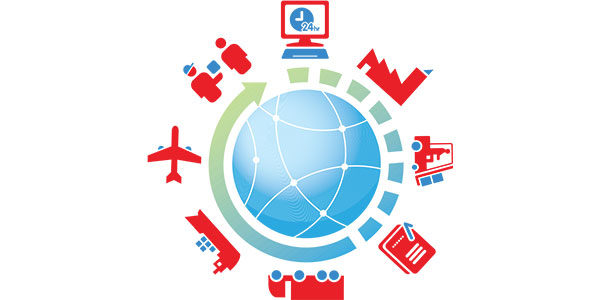Report says U.S. logistics system has entered a "new order" marked by historically sub-par volumes, grudging gains

Every year for the past four, transportation and logistics professionals have waited for the high priestess of industry data, Rosalyn Wilson, to deliver them from the near-ruins of the Great Recession and into the land of bountiful returns that many had grown accustomed to prior to the downturn.
Judging by the conclusions of the Council of Supply Chain Management Professionals 24th annual "State of Logistics Report," which Wilson authors, they may have some more time to wait—at least a couple of more years.
The report, which was released today in Washington, D.C., chronicles the nation's logistics output in 2012. In it, Wilson writes that the logistics industry may be experiencing a "new order," characterized by the bump-along-the-bottom growth that has marked the post-recession era. This pattern of sluggish growth will last at least until the end of 2015, she predicts.
"The economy and the logistics sector will slowly regain sustainable momentum, but we will still experience unevenness in growth rates," Wilson writes in the report.
The picture for 2013, at least through mid-year, has a similar look to the past two years, said Wilson, whose data-crunching continued right up to the report's release. As she gathered the data and prepared her narrative, Wilson said she realized "there was not a truly new story to tell."
Recoveries in the housing and automotive sectors have been a welcome positive, she said. Offsetting those strengths, though, have been the impact of the 10-percent across-the-board federal budget cuts mandated under "sequestration;" a rise in payroll tax deductions to historical norms; higher operating costs for logistics service providers; and a global economic slowdown, she added.
Among the findings in the 2012 report:
�?� U.S. logistics costs reached $1.33 trillion, a 3.4-percent gain from 2011 levels. The rate of increase was less than half of the year-on-year increase from 2010 to 2011. Similarly, transportation costs borne by users of the logistics system rose 3 percent, about half the rate of increase reported from 2010 to 2011. Logistics costs as a percentage of nominal gross domestic product (GDP)—a ratio often cited to measure the supply chain's efficiency in moving the nation's output—came in at 8.5 percent, the same as in 2011. These trends reflect the impact of slow economic growth as well as gains in productivity, asset utilization, and inventory management made by the supply chain sector since the recession ended, according to Wilson. These improvements will allow the ratio to remain at low levels even as business and shipping activity rises through the years, she said. The ratio "compares quite favorably to that of our trading partners," she said.
�?� Inventory carrying costs rose 4 percent, as rising inventory levels in part neutralized the continued decline in interest rates. Business inventories rose in every quarter but the second. Inventory levels in the first quarter surpassed the levels of the third quarter of 2008, considered to be the worst quarter of the recession. Retail, wholesale, and manufacturing inventories all rose in 2012, with retail inventories increasing by 8.3 percent, more than double the increase of wholesale inventories and more than six times the rise in manufacturing inventories.
For all their efforts to reduce inventory levels through better forecasting methods, retailers still found themselves overstocked as retail sales began flagging in May after a strong start to the year, Wilson said. Over time, retailers will become more adept at pushing inventory back upstream through the supply chain, especially to wholesalers, Wilson said. However, the slowing inventory velocity caused in part by the decline in consumer activity from May onward caught everyone—including the retailers—flat footed, she said. "Inventory is not moving, period," she said in an interview several days before the report's release. Retail stocks must be drawn down considerably for the economy to fully recover, Wilson said.
�?� Warehousing costs increased by 7.6 percent as rising inventories fully absorbed warehouse capacity, which had already been pared back during and immediately after the recession. As a result, leasing rates also rose, the report said. New construction took up some of the slack but rising occupancy rates offset the capacity increases, the report said.
�?� Trucking costs—essentially defined as rates paid by modal users—increased by 2.9 percent. Intercity trucking costs rose 3.1 percent, while "local delivery," or non-intercity, costs climbed 2.1 percent. Truck tonnage increased 2.3 percent over 2011 levels. Truckers have been satisfied with their tonnage activity through the first half of 2013, Wilson said. However, they have been disappointed in their inability to raise prices to levels needed to neutralize a host of rising costs from labor to equipment and still make a decent return, she said.
The report predicted that the shortage of qualified drivers, now believed to stand at about 30,000, could swell to nearly four times that by 2016. That increase will be caused by various government regulations that will take drivers off the road as well as industry struggles to hire and retain younger drivers to replace those who retire, quit, or die. Only about 17 percent of the current driver population is under 35, according to the report.
�?� Rail transport costs paid by users rose 4.9 percent, down from an increase of more than 16 percent in 2011. The large drop came despite the second best year on record for intermodal volume and a leveling off in a severe multi-year decline in coal traffic, which accounted for more than 40 percent of rail tonnage. Wilson said rail equipment and infrastructure is ample and in excellent shape, a result of the industry pouring a record $13 billion last year into capital spending, a 16.1-percent increase over 2011 levels.
Wilson blamed the sharp decline in rail shipping costs on fall-offs in tonnage for coal, grain, and chemicals, which accounted for 62 percent of total tonnage hauled. Intermodal, despite reporting year-over-year gains, came under severe rate pressure from truck competition, especially as railroads began expanding into shorter-haul lanes traditionally the province of motor carriers. Three commodities reporting tonnage gains—petroleum products; motor vehicles and equipment; and crushed stone, sand, and gravel—comprised only 15 percent of rail tonnage last year, according to the report.
�?� The ocean and international air sectors had a tough time of it last year with slack global economies and a glut of capacity combining to curb demand and pricing. For example, ocean costs fell by 0.9 percent last year as vessel capacity rose 7.2 percent. Capacity is expected to rise by 10 percent in 2013 as new vessel deliveries exceed demand to fill it, Wilson said.
The report is produced by the Council of Supply Chain Management Professionals (CSCMP) and sponsored by Penske Logistics.
Related Articles

Copyright ©2024. All Rights ReservedDesign, CMS, Hosting & Web Development :: ePublishing